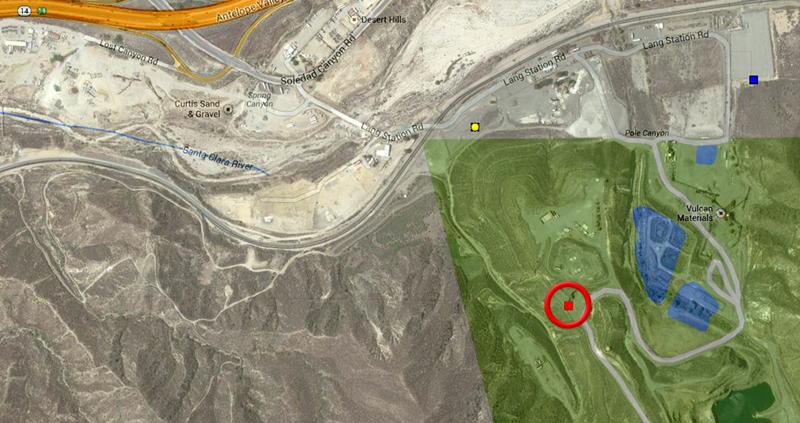|
|
Lang, California (Canyon Country)

Click image to enlarge Push a button at Magic Mountain (the mountain south of Newhall, not the amusement park in Valencia), and a battery of Nike missiles would theoretically blast off from the hills south of the historic Southern Pacific Lang Depot, on land currently being mined for sand and gravel. The red circle marks the location of the Nike missile battery. The source of the map is the California Department of Toxic Substances Control. The missile site was operational from 1955 to December 1968, although the missile battery closed in 1963 because this site didn't make the transition from Nike Ajax missiles to the nuclear-capable Hercules variety. (An example of the second stage of a Nike Ajax missile, which had a 25-mile range and three fragmentation-type warheads, can be seen next to the American Legion Hall on Spruce Street in Newhall.) In response to a DTSC inquiry, on May 9, 1994, the Department of Defense (Defense Environmental Restoration Program) declared the site ineligible for DTSC oversight on grounds that it was under the purview of the Angeles National Forest. As of July 1, 2005, the site has had a DTSC status of "Inactive – Needs Evaluation." On the map, the yellow dot just right of center is associated with Lubrication Company of America at 12500 Lang Station Road. The actual cleanup site is the dark blue square in the upper right-hand corner. LCA operated a waste oil recycling facility on the 4-acre site immediately south of the train tracks along the southern bank of the Santa Clara River from 1956 to 1989. Per a DTSC report, "The facility began producing sulfur-cutting oil from waste diesel, bunker oil and jet fuel by reprocessing the waste oil and adding sulfur compounds and acids as additives." Rail cars and tanker trucks transported waste oil to the facility, where it was "reclaimed by adding sulfur monochloride and sulfuric acid, to precipitate the metals contained in the waste oils. Cutting oils produced through this process were then skimmed off the top, treated with acid and sold." The trouble, according to a DTSC report, is that "animal fat-based oil, petroleum-based oil and associated compounds, sulfur compounds and acids were suspected to have been released to the site soils. Several site inspections were conducted by regulatory agencies between 1979 [and] 1985, and violations were noted." DTSC started putting pressure on the company in the early 1980s when its inspectors observed and confirmed releases of contaminants into the soil and water. LCA filed for bankruptcy protection in September 1985; in 1987 DTSC made the site eligible for state cleanup funding. Between 1989, when the facility closed, and 1992, DTSC removed waste from 61 above-ground tanks, disposed of 358 drums containing waste, and removed asbestos materials from the site. The soil was extensively contaminated to a depth of 70 feet. Contaminants included heavy fractions of petroleum hydrocarbons and aliphatic oils (animal fat source, covering half of the surface of the 4-acre site); as well as volatile aromatic compounds (ethylbenzene, toluene, xylene isomers); volatile halogenated organics — l,l,-dichloroethane (DCA), l,l,l-trichloroethane (TCA), trichloroethylene (TCE), tetrachloroethylene (PCE) —; polycyclic aromatic hydrocarbons (PAHs); PCB; lead; and acids. Soil contaminants were also found off-site, including the railway spur area, where surface runoff drains into the Santa Clara River. The level of historic contamination of the river from the operation is unknown, but as of 1998, volatile organic compounds were detected in the groundwater beneath the site. DTSC issued a Final Remedial Action Plan on Dec. 17, 1999. DTSC opted to "dismantle onsite structures, evacuate and dispose of contaminated offsite soil in the railroad spur area, backfill to grade, cap the onsite soil, construct and operate a soil vapor extraction (SVE) system and perform groundwater monitoring" and to implement "groundwater treatment using air sparging. Bioventing techniques would be incorporated in conjunction with the SVE to remediate the heavy-end petroleum hydrocarbons in the soil." Thirty years of groundwater monitoring had been recommended back in 1992, but the monitoring stopped in 1998 and didn't restart. Neither the air sparging nor the bioventing was conducted. The site was capped with asphalt, with an underlying geosythetic clay liner. With an "industrial" land-use designation, the site was redeveloped in 2007 for use as additional space for SSA Marine's adjacent container terminal. According to a DTSC report dated Jan. 11, 2013, "The redevelopment included new asphalt pavement over much of the parcel and installation of paved truck ramps to support the storage of flatbed truck trailers that are used to transport containers. The site is currently used for the storage of flat-bed truck trailers and transport containers." The soil vapor extration (SVE) continues. Download: DTSC: Final Remedial Action Plan for Lubrication Company of America Site (Part 1), 12-17-1999 DTSC: Final Remedial Action Plan for Lubrication Company of America Site (Part 2), 12-17-1999 DTSC: (First) Five-Year Review, Lubrication Company of America Site, 1-11-2013
LW2611: 19200 dpi jpeg from jpeg version of map. |
Nike Missile System: Historical Overview Los Pinetos-Newhall Site History (HAER) 
Army Housing 1959
|
The site owner makes no assertions as to ownership of any original copyrights to digitized images. However, these images are intended for Personal or Research use only. Any other kind of use, including but not limited to commercial or scholarly publication in any medium or format, public exhibition, or use online or in a web site, may be subject to additional restrictions including but not limited to the copyrights held by parties other than the site owner. USERS ARE SOLELY RESPONSIBLE for determining the existence of such rights and for obtaining any permissions and/or paying associated fees necessary for the proposed use.
